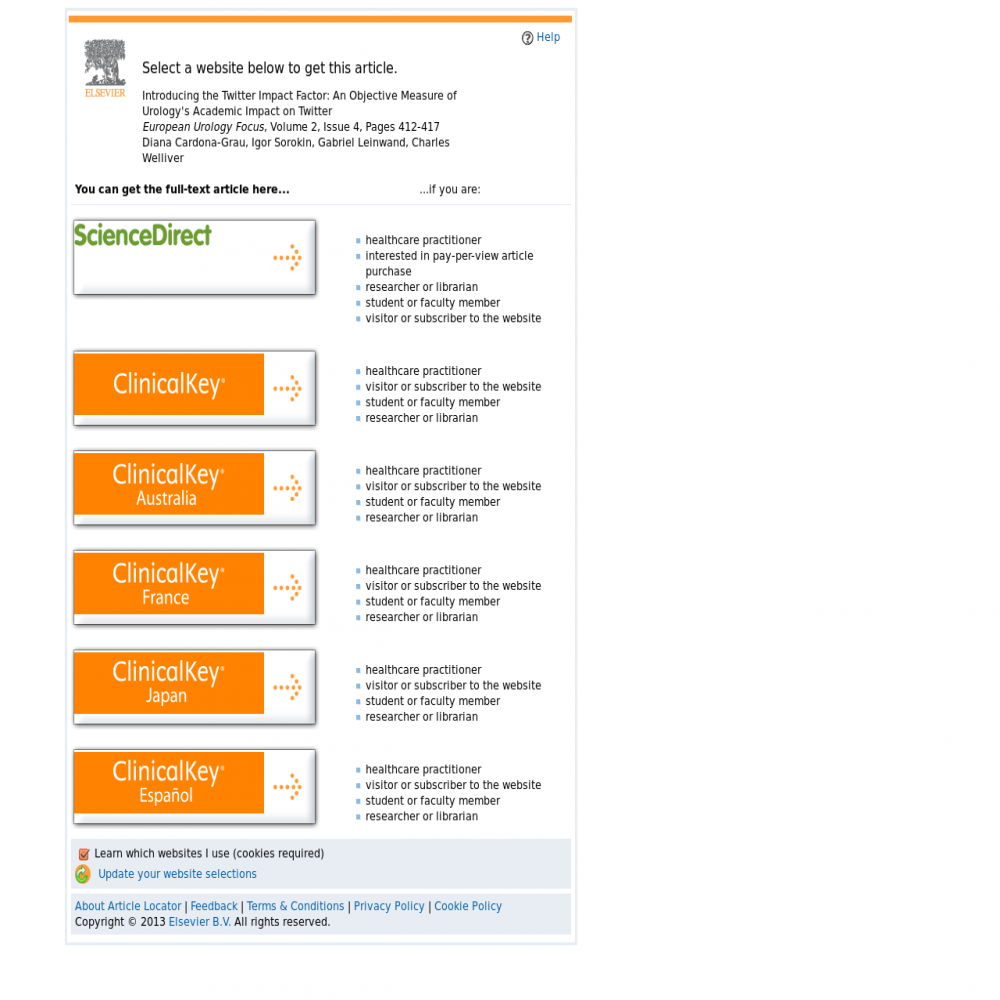Introducing the Twitter Impact Factor: An Objective Measure of Urology’s Academic Impact on Twitter
A healthcare social media research article published in European Urology Focus, October 1, 2016
- Title
- Introducing the Twitter Impact Factor: An Objective Measure of Urology’s Academic Impact on Twitter
- Authors (alpha)
- Charles Welliver, Diana Cardona-Grau, Gabriel Leinwand, Igor Sorokin
- Published
- October 1, 2016
- Journal
- European Urology Focus
- Impact Factor
- 14.976
- DOI
- 10.1016/j.euf.2016.03.006
- Pubmed
- 28723474
- Altmetric
Abstract
Social media use in academia and urology is rising. Specifically, individual journals now have Twitter accounts (Twitter Inc, San Francisco, CA, USA) and regularly tweet academic content. To present and evaluate the Twitter impact factor (TIF), a novel means of measuring a journal's academic influence in the realm of social media. Journal Citation Reports (JCR; Thomson Reuters, New York, NY, USA) for 2014 was queried for urologic academic journals. English-language journals with active Twitter accounts since 2013 were included. The total number of followers, tweets, and retweets over a 2-yr period were collected. Each journal's TIF was calculated based on the number of retweets per original relevant tweet. Comparisons between the TIF and the journal impact factor (JIF) as well as the Klout score were made using the Pearson correlation. Of 33 journals listed in the JCR for 2014, 7 (21%) had a Twitter presence as of 2013. The number of JCR-listed journals with a Twitter handle increased by 29% in 2014. There was an increase in the mean number of relevant tweets per journal during the study period and a 130% increase in the number of retweets over 1 yr. European Urology (1.80) and BJU International (1.46) had the highest TIFs. The journals with the highest number of Twitter followers were European Urology (5807) and the Journal of Urology (4402). The journals with the highest numbers of relevant tweets were European Urology (1159) and BJU International (1090). There was a positive but statistically insignificant association between the TIF and the JIF (r=0.64, p=0.12). There was a strongly positive linear correlation between the TIF and the Klout score (r=0.84, p=0.0086). With the increasing use of social media by individuals and academic journals, the TIF can be a useful tool to measure the academic reach and impact of a journal on Twitter. Social media is an increasing part of the way in which practitioners and academicians communicate. The TIF can be used to analyze the impact of journal Twitter feeds and their social media content.
Altmetric
The Altmetric Attention Score is based on the attention a research article gets on the internet. Each coloured thread in the circle represents a different type of online attention and the number in the centre is the Altmetric Attention Score. The score is calculated based on two main sources of online attention: social media and mainstream news media.
Healthcare Social Media Research
See the full list of healthcare social media research articles with data from or reference to Symplur.
#hcsmR is a collaboration between Stanford Medicine X and Symplur.


